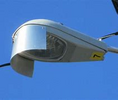As you can see his retinas are fully lit by the IR.
So that 3-4 nights of 8 hour nighttime driving a week is quite a bit of IR exposure.
You demonstrate an important point here.
@Nigel likes to mention that infra-red light is prevalent in sunlight, but he leaves out a significant factor in how IR emitters shining directly into your face at close range might potentially have a detrimental affect on your eyes over time.
Should remember that sunlight contains large amounts of near IR relative to what you will get from a dashcam.
When we are out in bright sunlight (which also contains UV light along with infra-red wavelengths), our pupils naturally close down to protect our retinas.
In the darkness of an automobile cabin at night our pupils are nearly fully dilated. So, when subjected to the IR emissions from the LEDs our eyes do not have the natural protection they would have had in full sunlight. So, even if the intensity is low, over a long period of time our retinas are exposed to focused close range IR light in a way that may be more than trivial. (by focused, I mean that LEDs have lenses built into them to project the light emitted by the diode.)
Dilated or normally open pupils are the reason we get red eye in traditional flash photographs, for example. When the camera's flash goes off the subject's pupils are still open so the flash is seen reflecting off the person's retina in the photo. That is the exact same thing that is happening in the screen grab from the A139 video, but unlike during a photo flash, the subject's pupils do not immediately close down, but instead they remain open.
I still believe the risk is probably very low, but the fact is that we really don't know for certain and as far as I am aware, this scenario has not been studied. Full time IR emitters operating inside automotive cabins is quite a new phenomenon.
It reminds me a bit of what has happened over the years with the emergence of flat panel computer screens. In the beginning there were no health concerns, but the longer these screens have been on the market, the more studies have shown how the blue light they emit causes eye strain, can damage your retinas, affects melatonin levels and causes sleep cycle changes. One recent study found that people who work the night shift and are exposed to excess blue light are at greater risk for breast, prostate, and colorectal cancers.









